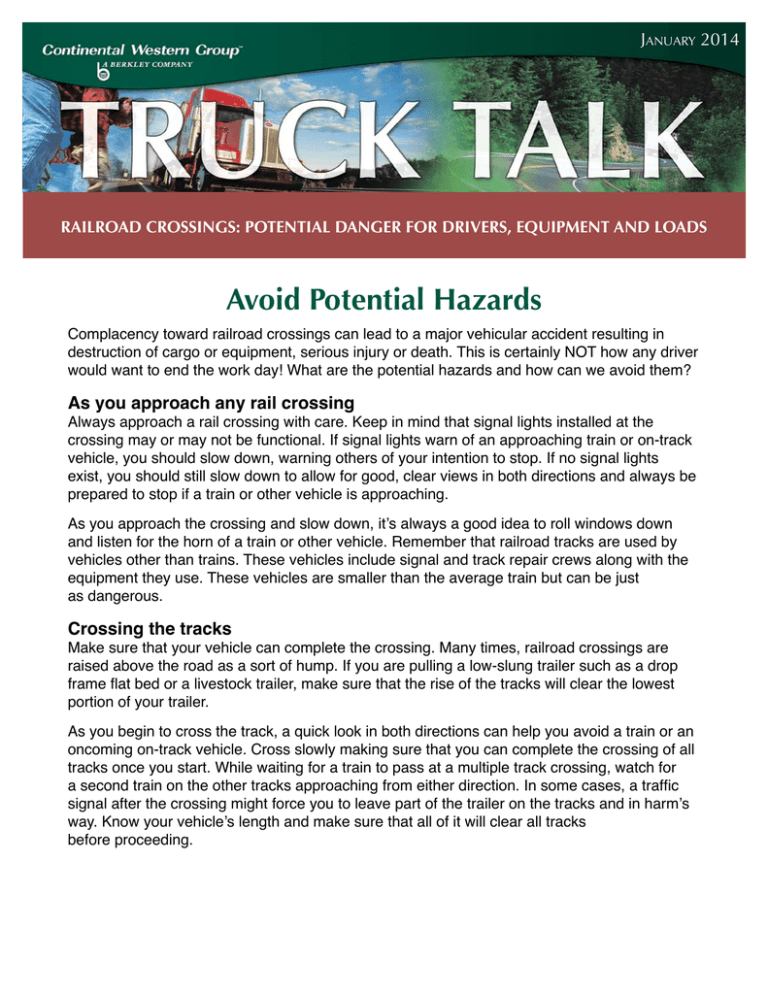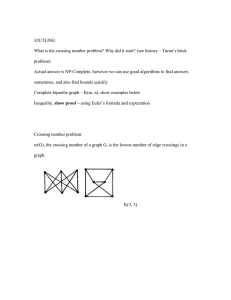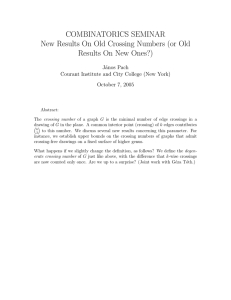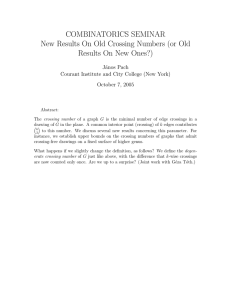
January 2014
Railroad Crossings: Potential Danger for Drivers, Equipment and Loads
Avoid Potential Hazards
Complacency toward railroad crossings can lead to a major vehicular accident resulting in
destruction of cargo or equipment, serious injury or death. This is certainly NOT how any driver
would want to end the work day! What are the potential hazards and how can we avoid them?
As you approach any rail crossing
Always approach a rail crossing with care. Keep in mind that signal lights installed at the
crossing may or may not be functional. If signal lights warn of an approaching train or on-track
vehicle, you should slow down, warning others of your intention to stop. If no signal lights
exist, you should still slow down to allow for good, clear views in both directions and always be
prepared to stop if a train or other vehicle is approaching.
As you approach the crossing and slow down, it’s always a good idea to roll windows down
and listen for the horn of a train or other vehicle. Remember that railroad tracks are used by
vehicles other than trains. These vehicles include signal and track repair crews along with the
equipment they use. These vehicles are smaller than the average train but can be just
as dangerous.
Crossing the tracks
Make sure that your vehicle can complete the crossing. Many times, railroad crossings are
raised above the road as a sort of hump. If you are pulling a low-slung trailer such as a drop
frame flat bed or a livestock trailer, make sure that the rise of the tracks will clear the lowest
portion of your trailer.
As you begin to cross the track, a quick look in both directions can help you avoid a train or an
oncoming on-track vehicle. Cross slowly making sure that you can complete the crossing of all
tracks once you start. While waiting for a train to pass at a multiple track crossing, watch for
a second train on the other tracks approaching from either direction. In some cases, a traffic
signal after the crossing might force you to leave part of the trailer on the tracks and in harm’s
way. Know your vehicle’s length and make sure that all of it will clear all tracks
before proceeding.
Stopped or stuck on the tracks?
Get out of your vehicle and to safety immediately!
It’s fairly safe to say that if you can see a train, it’s
probably not going to be able to stop. Fully-loaded
trains can take up to a mile to stop. Walk toward
the train, but not on or near the tracks, to a safe
location. Remember that a railroad car can be up
to 3 feet wider (on each side) than the tracks.
Call the authorities (dial 9-1-1) and notify them
of where and how your vehicle is stopped on
the tracks. Location information is posted on the
crossing gate, signal pole or switch house and is
noted as a DOT or AAR crossing number. Some
crossings have the emergency number of the
railroad that operates the tracks posted near the crossing sign or gate. If this information is
available, a call should be made after the law enforcement authorities have been notified.
As railroads streamline their operations and phase out some tracks, the use of remaining
tracks tends to rise. As an example, in Detroit Lakes, MN a train passes through the
metropolitan area every 20 minutes. Statistically, there has been a 30% reduction in the
number of highway rail crossings nationally. Logically, remaining crossings are busier. Railroad
crossing gates are installed at approximately 35% of the total crossings.
Remember to ALWAYS EXPECT A TRAIN! SLOW DOWN, LOOK BOTH WAYS AND LISTEN!
ckovachevich@cwgins.com
Continental Western Group and affiliated companies assume no liability in connection with your use or non-use of the information provided in this document and do not guarantee that the information contained herein includes all possible risks or unusual circumstances that may occur in or to your business
or that the advice or recommendations contained herein comply with all federal, state or local laws or regulations. Any advice or recommendations made in
this document are intended to assist you in reducing risk of loss, thereby reducing the possibility that our companies will need to make a payment under an
insurance policy. These recommendations are not intended to substitute for any obligation that you or anyone else may have to survey, repair, or modify any
property, equipment or operations or to conduct safety programs. It is your legal responsibility to maintain safe premises, equipment and operations. This
document provides general information only, is not legal advice, and is not a statement of contract. Any statement regarding insurance coverage made herein
is subject to all provisions and exclusions of the entire insurance policy.
®
01-14 | Copyright © 2014 Continental Western Group®. All rights reserved.




